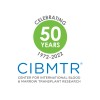
HLA-Mismatched Unrelated Donor Bone Marrow Transplantation With Post-Transplantation Cyclophosphamide...
Myelodysplastic Syndrome (MDS)Chronic Lymphocytic Leukemia (CLL)5 moreThis is a multi-center, single arm Phase II study of hematopoietic cell transplantation (HCT) using human leukocyte antigen (HLA)-mismatched unrelated bone marrow transplantation donors and post-transplantation cyclophosphamide (PTCy), sirolimus and mycophenolate mofetil (MMF) for graft versus host disease (GVHD) prophylaxis in patients with hematologic malignancies.

Study of the Glutaminase Inhibitor CB-839 in Leukemia
Acute Myeloid Leukemia (AML)Acute Lymphocytic Leukemia (ALL)Many tumor cells, in contrast to normal cells, have been shown to require the amino acid glutamine to produce energy for growth and survival. To exploit the dependence of tumors on glutamine, CB-839, a potent and selective inhibitor of the first enzyme in glutamine utilization, glutaminase, will be tested in this Phase 1 study in patients with leukemia. This study is an open-label Phase 1 evaluation of CB-839 in subjects with leukemia. Part 1 is a dose escalation study to identify the recommended Phase 2 dose as a single agent and in combination with azacitidine. Patients enrolled into Part 2 will be treated with the recommended Phase 2 dose. As an extension of Part 2, patients with relapsed/ refractory or newly diagnosed AML will be treated with CB-839 in combination with azacitidine. All patients will be assessed for safety, pharmacokinetics (plasma concentration of drug), pharmacodynamics (inhibition of glutaminase), biomarkers (biochemical markers that may predict responsiveness in later studies), and tumor response.

Human Placental-Derived Stem Cell Transplantation
Mucopolysaccharidosis IMucopolysaccharidosis VI14 moreThe purpose of this clinical trial is to investigate the safety of human placental-derived stem cells (HPDSC) given in conjunction with umbilical cord blood (UCB) stem cells in patients with various malignant or nonmalignant disorders who require a stem cell transplant. Patients will get either full dose (high-intensity) or lower dose (low intensity) chemo- and immunotherapy followed by a stem cell transplantation with UCB and HPDSC.

A Phase II Study Evaluating the Safety and Efficacy of Subcutaneous Plerixafor
Related Donors Donating Peripheral Blood Stem Cells (PBSC) to a Family MemberAcute Myelogenous Leukemia6 moreThis is a Phase II, open-label, two strata, multicenter, prospective study of plerixafor-mobilized HLA-identical sibling allografts in recipients with hematological malignancies. This study will establish the safety and efficacy of subcutaneous plerixafor for this purpose.

A Phase II Open-Label Study of High-Dose Cytarabine and Clofarabine in Adult Patients With Refractory...
LeukemiaRATIONALE: Drugs used in chemotherapy, such as cytarabine and clofarabine, work in different ways to stop the growth of cancer cells, either by killing the cells or by stopping them from dividing. Giving more than one drug (combination chemotherapy) may kill more cancer cells. PURPOSE: This phase II trial is studying clofarabine when given together with cytarabine to see how well they work in treating patients with refractory or relapsed acute myeloid leukemia or acute lymphoblastic leukemia.

Trial to Assess the Efficacy of a TCR Alfa Beta Depleted Graft in Pediatric Affected by ALL or AML...
Acute Lymphoblastic LeukemiaLeukemia Acute Myeloid - AML2 moreAllocation: Non-Randomized Endpoint Classification: Safety/Feasibility Intervention Model: Single Group Assignment Masking: Open Label Primary Purpose: Treatment Study to assess the feasibility and safety of the infusion of a T cells receptor (TCR) alfa beta depleted graft in pediatric patients affected by malignant and non-malignant hematological disorders and receiving an Hematopoietic stem cell transplantation (HSCT) from a Human leukocyte antigen (HLA) partially matched family donor.

Safety and Efficacy Study of Donor Natural Killer Cells Given After Haploidentical Hematopoietic...
Acute Myelogenous LeukemiaAcute Lymphoblastic LeukemiaThe protocol treatment is to evaluate clinical effects of donor-derived natural killer cells that are given after HLA-mismatched hematopoietic cell transplantation.

Vorinostat, Cytarabine, and Etoposide in Treating Patients With Relapsed and/or Refractory Acute...
Accelerated Phase Chronic Myelogenous LeukemiaAdult Acute Basophilic Leukemia34 moreThis phase I trial is studying the side effects and best dose of vorinostat when given together with cytarabine and etoposide in treating patients with relapsed or refractory acute leukemia or myelodysplastic syndromes or myeloproliferative disorders. Vorinostat may stop the growth of cancer cells by blocking some of the enzymes needed for cell growth. Drugs used in chemotherapy, such as cytarabine and etoposide, work in different ways to stop the growth of cancer cells, either by killing the cells or by stopping them from dividing. Giving vorinostat together with cytarabine and etoposide may kill more cancer cells.

Etanercept in Treating Young Patients With Idiopathic Pneumonia Syndrome After Undergoing a Donor...
Accelerated Phase Chronic Myelogenous LeukemiaBlastic Phase Chronic Myelogenous Leukemia23 moreThis phase II trial is studying how well etanercept works in treating young patients with idiopathic pneumonia syndrome after undergoing a donor stem cell transplant. Etanercept may be effective in treating patients with idiopathic pneumonia syndrome after undergoing a donor stem cell transplant.

German Multicenter Trial for Treatment of Newly Diagnosed Acute Lymphoblastic Leukemia in Adults...
Adult Acute Lymphocytic LeukemiaThe study evaluates the efficacy and tolerability of an intensified induction and consolidation therapy. Thereafter patients receive individualised treatment stratified according to relapse risk with stem cell transplantation for patients with high and very high risk of relapse. Patients with standard risk receive further consolidation and reinduction chemotherapy. In parallel minimal residual disease (MRD) is evaluated. After six months and one year the decision on intensification or discontinuation of therapy is made based on the results of MRD evaluation.
